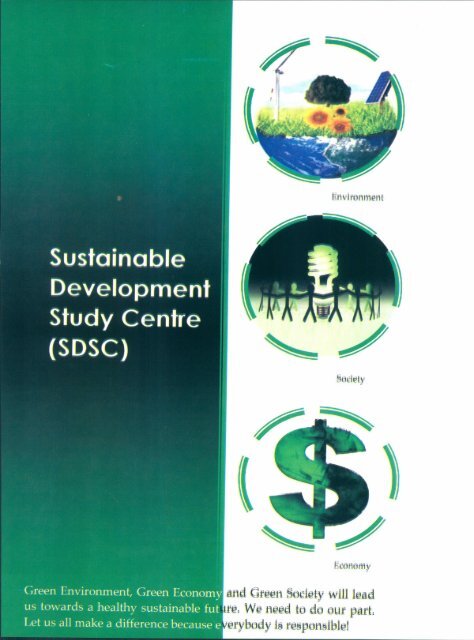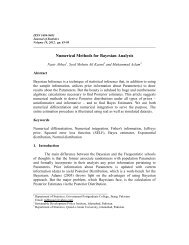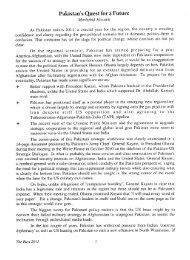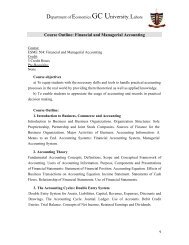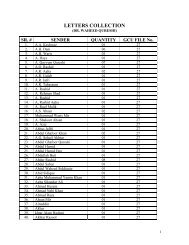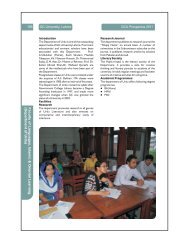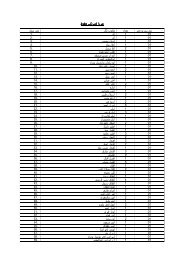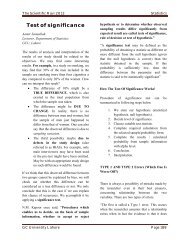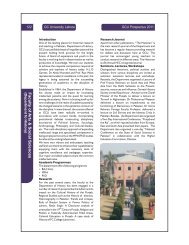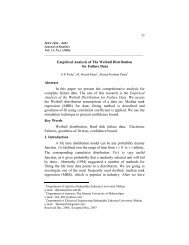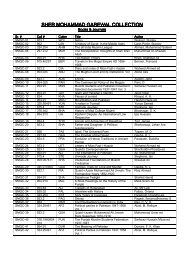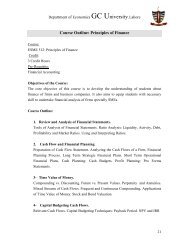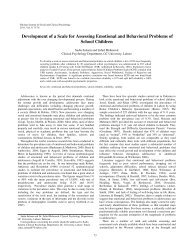The Scientific Ravi 2011 - Government College University
The Scientific Ravi 2011 - Government College University
The Scientific Ravi 2011 - Government College University
You also want an ePaper? Increase the reach of your titles
YUMPU automatically turns print PDFs into web optimized ePapers that Google loves.
••<br />
emd er~~ftSod~ty wHll~ad<br />
r~l W~ ft~~d ftJ do OUrpart<br />
'~fyb(}dy Ie f~ep(}ftelbl~!
<strong>The</strong> <strong>Scientific</strong> <strong>Ravi</strong> <strong>2011</strong><br />
Absorption of Pollutants and<br />
Production of Renewable Fuel:<br />
Potential of Algae in Pakistan<br />
Farooq Ahmad<br />
FaclIll)' J1ember & PhD Scholar<br />
In Pakistan. economic growlh has generally<br />
been achieved at the cost of the<br />
environment. since most production and<br />
manufacturing processes exploit healthy. but<br />
scarce ecosystems. <strong>The</strong> hellvy dependence<br />
on natural resources and resulting<br />
environmental degradation has generated a<br />
cycle' of "ecological poverty" with<br />
implications for the sustainability of<br />
economic growth.<br />
Studies conducted recently by the<br />
<strong>Government</strong> and donor agencies in Pakistan<br />
have highlighted a number of environmental<br />
issues. Broadly. the affected areas include<br />
water. energy. wastc management. irrigated<br />
agriculture and biodiversity. Overall. these<br />
studies reveal deterioration in all these areas<br />
but the increasing pollution of water bodies<br />
and energy crisis have an enormous impact<br />
on environmental conditions in Pakistan.<br />
<strong>The</strong> <strong>Government</strong>. private sector and civil<br />
society have not responded adequately to<br />
meet these challenges. although there have<br />
been some exceptions. such as the<br />
s\\ itchover to cleaner fuels in the transport<br />
sector. but still there is need to do more.<br />
Algae in this respect can playa vital role not<br />
only to treat wastewater. but to produce<br />
environment friendly biofuels. Algae are a<br />
diverse group of simple plant-like<br />
organisms. growing in fresh water and sea<br />
water. A specific group of algae are capable<br />
of producing oil more than 50 times than<br />
other oilseed crops. At present. the crude oil<br />
price in the world is around US$<br />
120fBarrcl. One renewable and pollution<br />
SDSC<br />
free energy source is biodiesel produced<br />
from natural oils. which arc non-edible like<br />
Algae (Kai). Jatropha (Jamal Gota).<br />
Pongame (Sukh Chain) and Castor<br />
(Arhand). Biodiesel burns cleaner than<br />
conventional gasoline while having similar<br />
efficiency as that of fossil fuel. <strong>The</strong> potential<br />
of biodiesel production can be made<br />
economical by growing Algae (Kai) in<br />
marginal land. in saline water or in the waste<br />
water ponds. Certain species of algae can<br />
produce 5.000-20.000 gallons of oil per acre<br />
per year.<br />
<strong>The</strong> <strong>Government</strong> of Pakistan announced<br />
that 10% blending of petroleum with<br />
biodiesel should start from 2015. Algae can<br />
also be economically converted into solid<br />
fuels. methane gas. or bio-ethanol. It can<br />
also be used to generate electricity which in<br />
turn can be used to obtain hydrogen fuel to<br />
power hydrol:en fuel cells. <strong>The</strong> amount of<br />
land requirement for growing algae is also<br />
minimal as compared to other oil yielding<br />
crops. Pakistan can use its 27million acre of<br />
saline lands to cultivate algae. which is the<br />
best alternative feedstock to biofuel<br />
production. It is estimated that Pakistan's<br />
import bill can be reduced by Rs. 69.5<br />
billion if only biodiesel produced from nonedible<br />
raw materials is used in the<br />
transportation sector. <strong>The</strong>re arc a number of<br />
species of Algae (Chlorella. Scenede.l'mll.l'.<br />
Cladophora etc.) identified. which arc<br />
suitable to climatic conditions of<br />
Pakistan. Alglle having good oil yield can<br />
be grown and harvested very quickly.<br />
<strong>The</strong> cultivation of Algae is expected to bring<br />
double benefit to the environment in the<br />
sense that Algae can be used to extract<br />
nutrients from waste water. which it<br />
converts to fats for bio diesel<br />
production. Algal biodiesel resource<br />
requirement is land. water and CO 2 . this can<br />
support biodiesel production and CO 2<br />
GC <strong>University</strong>. Lahore<br />
171
<strong>The</strong> <strong>Scientific</strong> <strong>Ravi</strong> <strong>2011</strong><br />
savings. Thus the scientists believe that the<br />
"Algae absorbs pollutants & gives us<br />
biodiesel" and during biodiesel production<br />
glycerin is obtained as valuable by-product.<br />
whose market price is Rs. 170/1iter.<br />
<strong>The</strong>re are three well-known methods to<br />
extract the oil from algae: (i) expeller/press<br />
(ii) solvent extraction with hexane and (iii)<br />
supercritical lluid extraction. A simple<br />
process is to use a press to extract a large<br />
percentage (70-75%) of the oils out of<br />
algae. Algal oil can also be extracted using<br />
chemicals. <strong>The</strong> most popular chemical for<br />
solvent extraction is hexane. which is<br />
relatively inexpensive. Supercritical lluid<br />
extraction is far more eflicient than<br />
traditional solvent separation methods.<br />
Supercritical lluids are selective. thus<br />
providing the high purity and product<br />
concentrations. This can extract almost<br />
100% of the oils all by itself. In the<br />
supercritical fluid carbon dioxide (C02) is<br />
extracted and liquefied under pressure then<br />
heated to the point that it has the properties<br />
of both a liquid and gas. This liquefied lluid<br />
then acts as the solvent in extracting the oil.<br />
<strong>The</strong> chemical conversion of the oil to its<br />
corresponding fatty ester (biodiesel) is<br />
called transesterification. Transesterification<br />
refers to a reaction between an ester<br />
(triglyceride) of one alcohol (glycerin) and a<br />
second alcohol (methanol) to form an ester<br />
of the second alcohol (methyl ester).<br />
Hundreds of scientific articles and various<br />
other reports from around the world dealing<br />
with vegetable oil-based alternative diesel<br />
fuels or biodiesel have appeared in print.<br />
<strong>The</strong> main feedstock for producing biodiesel<br />
are rapeseed oil in Europe and soybean oil in<br />
the United States but algae can be the best<br />
option to replace these oi lseed crops.<br />
SDSC<br />
barren lands for abundant biofuel<br />
production. Usually Algae contains about 40<br />
percent of oil and 60 percent residual biomatter.<br />
hence after extracting 40 percent of<br />
oil which can be used for biodiesel<br />
production. the left over 60 percell! biomatter<br />
can be used for animal feed.<br />
bioethanol production and some other<br />
purposes mentioned above. Pakistan Council<br />
of <strong>Scientific</strong> and Industrial research (PCSIR)<br />
is undertaking a research project to<br />
determine the feasibility of growing algae in<br />
saline water and wastewater ponds.<br />
Research on utilization of freshwater algal<br />
species for wastewater treatment and<br />
biodiesel production is also going on in<br />
Sustainable Development Study Centre. GC<br />
<strong>University</strong> Lahore.<br />
<strong>The</strong> advantages of using algal species<br />
include higher oil yield. cultivation in saline<br />
and wastewater ponds, a ready source of<br />
biomass for the production of heat energy,<br />
transformation of methane through algae<br />
culture grown material and the production of<br />
biological hydrogen for use in fuel cells.<br />
"<strong>The</strong> direct advantages to Pakistan include a<br />
pollution-free and greener Pakistan,<br />
employment for farmers. laborers and<br />
reduction in fossil fuel import. In addition<br />
import of fossil fuel from other countries<br />
will be reduced and local petroleum<br />
companies will also receive a welcome<br />
boost. Pakistan is depending on fossil fuel so<br />
there is dire need to establish a 'Biofuel<br />
Research Center' where we can focus to<br />
develop biofuel industry in the country using<br />
advanced technologies.<br />
Some countries had already started projects<br />
on saline algae farming to utilize their<br />
GC <strong>University</strong>,<br />
Lahore<br />
172
<strong>The</strong> <strong>Scientific</strong> <strong>Ravi</strong> <strong>2011</strong><br />
Bioplastics<br />
Conventional<br />
versus<br />
Plastics<br />
Fatella<br />
Bioplastics are the plastics which are<br />
manufactured using polymers derived from<br />
plant material called as biopolymers such as<br />
starch and cellulose. Some molecules<br />
deriwd trom plants, which are not polymers<br />
but are polymerizable, for example, lactic<br />
acid deri ved from corn and potatoes and<br />
triglycerides are also getting fame among<br />
scientists due to their appreciable role of<br />
these organic molecules in plastic synthesis.<br />
;-' ..1any plastic manufacturing companies are<br />
now concerned with the production of<br />
bioplastics and their use in coverings and<br />
packaging materials instead of conventional<br />
plastic. as the conventional plastic dumping<br />
is associated with emissions of hazardous<br />
gases. biophenoles (which are endocrine<br />
disrupters) and damaging of food chain.<br />
Dumping of plastics in oceans is one of the<br />
big issues regarding threats to aquatic life. It<br />
ha~ been reported that about 2.5 billion<br />
plastic bottles are dumped each year into<br />
oceans bv America alone which are less than<br />
30% or' the total dumped-plastic in the<br />
world. It is not that the conventional plastic<br />
is not degradable. but it requires hundreds of<br />
veal'S to-degrade which imposes threat to<br />
j'ood chain ~nd land resources. Moreover.<br />
polc-mer resins that are constituents of<br />
plastic are derived from petroleum and<br />
natural gas i.e. nOI1- renewable energy<br />
sourccs. This curtails the aspect of<br />
slistainabilit).<br />
On the other hand. biopolymers are obtained<br />
Irom the renewable energy sources like corn<br />
and soya bean. ivlanufacturing process<br />
involve; the biochemical process such as<br />
fermentation. To produce the constituents of<br />
bioplastics i.e. biopolymers scientists are<br />
tixusin~ on the use of al~ae ")I" this purpose<br />
- -<br />
GC <strong>University</strong>, Lahore<br />
SDSC<br />
along with the bacterial use. On the basis of<br />
their-biotic origin bioplastics are referred as<br />
biodegradable plastics. <strong>The</strong> recycling of<br />
such ;vpe of plastic is also a pollution tree<br />
proces's as compared to conventional plastics<br />
recycling.<br />
One school of thought is that. the<br />
conventional plastic production consumes<br />
only 4% of the total world oil and these are<br />
obtained as a byproduct of natural gas. crude<br />
oil extraction and refining process. Majority<br />
of the countries \\here plastic is produced<br />
have the recycling setup for petroleum based<br />
plastics. On the other hand. biopJastics<br />
production will have impact on<br />
eutrophication. pesticides pollution and<br />
ecotoxicitv. that is, there production carries<br />
environm~ntal cost as well. Introducing the<br />
bioplastics for recycling into already present<br />
recvcling streams will not be possible, new<br />
stn;clUr;s will be needed. Moreover<br />
bioplastics can not only be stemmed as<br />
green just because of the fact that these are<br />
derived from biomass. In fact. there is still<br />
no studv which could prove that the<br />
degradation will be really very rapid and if<br />
th;v are reallv readilv degradable (as now it<br />
has' been w~rked O~il by scientists). then<br />
what's the assurance that thei I'<br />
decomposition will not release any harmful<br />
product and one step ahead degradation of<br />
that harmful products will be rapid or nol.<br />
So to s\\ itch to the bioplaslics from<br />
petroleum based plastics may not<br />
necessarily be a grecn and sustainable step.<br />
Certain t;lCts arc ignored b" the critics lhat<br />
althouoh onlv 4'Y; of the - world total oil<br />
produc~ion i~ consumed in conventional<br />
plastic pmduction but how much this 4%<br />
along \\'lth the production process and<br />
dumping process is contributing towards<br />
glohal \varming and eco toxicity is not<br />
~onsidered. Re~earchers have fo'und that<br />
production of bioplasties require less t,'ssil<br />
173
<strong>The</strong> <strong>Scientific</strong> <strong>Ravi</strong> <strong>2011</strong><br />
fuels so less contribution towards global<br />
warming and reduced resource depletion as<br />
well. As for as recycling is concerned, the<br />
recycling and incineration of conventional<br />
plastic are generating a serious air pollution<br />
problem. Despite of the fact that less than<br />
2% of the plastic is recycled each year in the<br />
countries<br />
like USA.<br />
Viewing all the above mentioned facts. if the<br />
plastic which is expected to degrade rapidly<br />
due to their biotic origin and its production<br />
use and dumping will not impose<br />
devastating threats to environment as<br />
compared to conventional plastic consuming<br />
less energy as well are recycled atier their<br />
use, it will delinitely be a good step towards<br />
protection of resources and environment. In<br />
SDSC<br />
China, Biodegradable plastic capacity<br />
reached to 80.000tones in 2007. China<br />
exported more than 95% of the bioplastics to<br />
developed countries Iike Europe and<br />
America (Global and china biodegradable<br />
plastic industry report. 20 I0). According to<br />
a report global demand for bioplastics is<br />
expected to reach 884,OOOtones by 2020.<br />
Although till 2009. bioplastics accounted<br />
less than I% of the global demand for<br />
plastic. (<strong>The</strong> future of bioplastics for<br />
packaging t02020. global market forecast).<br />
But it is an indication that markets are<br />
gradually shining from the conventional<br />
polymers towards biodegradable and<br />
compostable polymers.<br />
GC Uninrsity.<br />
L"horc<br />
174
<strong>The</strong> <strong>Scientific</strong> <strong>Ravi</strong> <strong>2011</strong><br />
Electronic Waste Disposal in<br />
Pakistan<br />
Ai=ai=-c-Flllima<br />
Electronic waste (E-waste) refers to the<br />
electronic equipment that has passed its<br />
average aj;e. This electronic waste comes<br />
from circuit boards. cathode ray tubes.<br />
connectors and other elements that are<br />
essentral for most electronic goods and<br />
alwavs contain poisonous substances such as<br />
lead.-tin. mercury. cadmium and barium.<br />
<strong>The</strong>se toxic compounds lead to serious<br />
health effects such as mental retard ness.<br />
censors. reproductive disorders. hormonal<br />
dvsfunction etc. Furthermore. chemicals<br />
s;Jch as beryllium. cadmium. chromium.<br />
lead and mercury that are used in computer<br />
motherboards. chip resistors/<br />
semiconductors. floppy disks.<br />
batteries/computer monitors. alkaline<br />
batteries respectively. pose severe health<br />
risks.<br />
Pakistan is thought to be a dumping site for<br />
electronic waste bv the developed states due<br />
to poverty and i~equality. At local level.<br />
electronic waste is dumped in municipal<br />
waste and burned. This releases<br />
carcinogenic substances in the air. A good<br />
exam pic can be that of Karachi. It is a major<br />
dumping site for electronic waste rrom all<br />
over the world. Most of the dumping occurs<br />
on board. in 5hershah and Lyari.<br />
Pcople do much of the manual work. which<br />
comprises of separating useful electronic<br />
parts such as copper and metal scrap. out of<br />
the dumped material. Workers are<br />
continually being exposed to the toxins and<br />
radii)active decays and are completely<br />
unaware or the harm rul effects of it. <strong>The</strong>y<br />
burn plastics and collect copper wires to sell<br />
in the market and use furnaces Itlr melting<br />
GC <strong>University</strong>. Lahore<br />
SDSC<br />
purpose without any safety measure. 50 far.<br />
no action plan has been devised nor any<br />
regulatory measure is taken for the proper<br />
disposal of electronic waste. however. some<br />
private sectors are working on it. for<br />
example. :vlobilink. It is a leading mobile<br />
phone operator in the country. and has<br />
initiated the Mobilink Handset Recycling<br />
Program in collaboration with the Pakistan<br />
Ass~eiation of the Deaf (PAD) and the<br />
Disabled We 1t:1re Association (DWA).<br />
According to this program. old and damaged<br />
mobile phones. batteries. chargers. and other<br />
such accessories are donated by dropping<br />
them in the bins that are speeilieally being<br />
placed for this purpose at defined sectors.<br />
<strong>The</strong>se cells are then collectcd and recycled.<br />
But People are unaware of this program. At<br />
local level. people use this common practice<br />
of dumping their electronic waste in<br />
municipal waste bins or by simply selling<br />
those items in private markets.<br />
From these markets. this electronic waste<br />
comes to Brantherd road in Lahore.<br />
<strong>The</strong> formal work of separating plastic and<br />
other metals is done manually.<br />
Hired laborers use hammers and other such<br />
things to I()rce open the locks of electronic<br />
equipments such as mobile phones. and<br />
make sure the complete separation of<br />
plastic. copper. iron. brass. nickel etc. all<br />
this process is done without any<br />
technological assistance.<br />
A Iter this separation. plastic is transported to<br />
the <strong>Ravi</strong> road Lahore. where furnaces are<br />
being placed and the proeess of melting<br />
Ol:eurs. Furnaces near Misri-Shah. Lahore.<br />
are used It>I" metal recvclin~. . ~ <strong>The</strong>v.<br />
have<br />
numbers assi~ned to each furnace. according<br />
to the quality~or the mctal being melted in it.<br />
This metal that is being melted forms<br />
dilferent layws according to its purity. <strong>The</strong><br />
175
<strong>The</strong> <strong>Scientific</strong> <strong>Ravi</strong> <strong>2011</strong><br />
pure metal. settles down and the highly<br />
impure and low quality iron. !loats on the<br />
surface. which is collected and used in<br />
making different machines such as electric<br />
motors. A part of it is sold to the steel mills<br />
too.<br />
Copper is collected as it settles down in the<br />
furnace through an outlet and collected in<br />
rod shapes. This melted material is thus<br />
recycled through this process and made to<br />
fine sheets on large scale or made to many<br />
useful moldings. with the help of a dye.<br />
SDSc.<br />
lies in their implementation in countries like<br />
Pakistan with poor economic growth and<br />
facilities.<br />
Below given are some of those examples<br />
that tell us how we can and should treat e-<br />
waste.<br />
[-waste<br />
Processing<br />
management<br />
techniques<br />
On other hand. plastic. which is collected<br />
alier melting. is mixed in different<br />
proportions with other useful elements and<br />
made into "prills". which are remolded into<br />
different many shapes. or sheets'. depending<br />
on the function it has to perform.<br />
<strong>The</strong> problem lies in the open dumping and<br />
direct exposure to the hazardous waste. As<br />
said earlier. residents and the hired labors<br />
are at a constant risk of becoming ill due to<br />
carcinogens and other radioactive<br />
substances. Plus, the leeched material. that<br />
finds its way to the water bodies. pollutes<br />
aquatic life and produces toxic effects in<br />
those who consume this water. Furthermore.<br />
open furnaces pose major threats to<br />
environmental air quality standards.<br />
Solutions to these problems can easilv be<br />
understood. if one considers health care<br />
measures. Workers should be provided with<br />
glo~es and masks and proper hygienic<br />
environment.<br />
Landfill sites should be monitored carefully<br />
so that the leechet may not lind its wav to<br />
the water table beneath: .<br />
Talking about the e-waste management.<br />
developed countries provide us with some of<br />
the examples. but the problem once again<br />
(Recyclillg<br />
{he lead FU/II balleriesj<br />
One example IS an "alternative bulk<br />
system"; a hopper conveys material for<br />
shredding into an unsophisticated<br />
mechanical separator. with screening and<br />
granulating machines to separate constituent<br />
metal and plastic fractions. which are sold to<br />
smelters or plastics recyclers. Such recycling<br />
machinery is enclosed and employs a dust<br />
collection system.<br />
A dust collection system is an air quality<br />
improvement system used in industrial.<br />
commercial. and home production shops to<br />
improve breathable air quality and safety by<br />
removing particulate matter Irom the air and<br />
environment. Dust collection systems work<br />
on the basic formula of CAPTURE.<br />
CONVEY and COLLECT:<br />
First the dust must be CAPTURED. This is<br />
done by employing devices such as capture<br />
hoods to catch the dust at the source of<br />
origin. i\olany times. the machine producing<br />
GC <strong>University</strong>,<br />
Lahore<br />
176
<strong>The</strong> <strong>Scientific</strong> <strong>Ravi</strong> <strong>2011</strong><br />
the dust will have an integral port to which a<br />
duct can be directly attached.<br />
Second. the dust must be COl\'VEYED. This<br />
is done via a ducting system properly sized<br />
and manit •.)ld 10 maintain a consistenl<br />
minimum air velocity required to keep the<br />
dust in suspension f •.)r convevance 10 the<br />
collection device. A mis-sized ducI can /ead<br />
to material settling in the duct system and<br />
clogging it.<br />
SDSC<br />
As for Trommel: A Trommel is a screencd<br />
cylinder used to separate materials b\ size _<br />
f•.)r example. separating the biodeg~,ldable<br />
fraction of l1li.,ed municipal \I'aste or<br />
separating di fferent sizes of crushed stolle.<br />
Finally. the dust is COLLECTED. This is<br />
done via a variety of means. depending on<br />
Ihe application and the dust being handled. It<br />
can be as simple as a basic pass-through<br />
filter. a cyclonic separator. or an<br />
impingement baffle. It ean also be as<br />
complex as an electrostatic precipitator. a<br />
multista~e.•.. ba~ ••... house. - or a chemical'" .<br />
treated \I et scrubber or stripping to\ler.<br />
Some of the emissions arc cau~ht b\'<br />
scrubbers and screens. Nlagnets.~ edd;'<br />
currents. and trommel screens arc employed<br />
to separate glass. plastic. and ferrous and<br />
non ferrous metals. \I h ich can then be further<br />
separaled at a smelter. Eddy currents (also<br />
called Foucaufl l'urrl'nts arc currents<br />
induced in conductors. \I hen a conductor is<br />
c.\POSI.:O to n changing Illagnetic Ijl.,.'ld due 10<br />
relati\e motion of the field sourcc and<br />
conductor: or duc to variations of the field<br />
\\ ith timc. This can cause a circulatin" 110\1<br />
of electrons. or a currcnt, \\'ithin Ihc b~d\ of<br />
the conductor. Thcse circulating eddie~ of<br />
currenl havc inductance and thus induce<br />
magnetic fields. <strong>The</strong>se fields can cause<br />
repulsive. attractive. propulsion and drag<br />
effecls. fhe strongcr the appficd magnetic<br />
field. or thc grcater thc elcctrical<br />
conductivily of thc conductor. l1I' the faster<br />
the field ehan~es. then the "reatcr the<br />
~ '"<br />
currcnts that arc devcloped and the greater<br />
the fields produced.<br />
(;C <strong>University</strong>',<br />
Lahore<br />
IAn uln'raring I rumll1
<strong>The</strong> <strong>Scientific</strong> <strong>Ravi</strong> <strong>2011</strong><br />
Hazardous smoke and gases are captured,<br />
contained, and treated to mitigate<br />
environmental threal. <strong>The</strong>se methods allow<br />
for safe reclamation of all valuable computer<br />
construction materials.<br />
Hewlett-Packard product recycling solutions<br />
manager Renee 51. Denis describes its<br />
process as: "We move them through giant<br />
shredders about 30 feet tall and it shreds<br />
everything into pieces about the size of a<br />
quarter. Once your disk drive is shredded<br />
into pieces about this big, it's hard to get t~p<br />
data otT'.<br />
An ideal electronic waste recycling plant<br />
combines dismantling for component<br />
recovery with increased cost-effective<br />
processing of bulk electronic waste.<br />
SDSC<br />
Additionally, recycling reduces the amount<br />
of greenhouse gas emissions caused by the<br />
manufacturing of new products. It simply<br />
makes good sense and is efficient to recycle<br />
and to do our part to keep the environment<br />
grcen.<br />
Environmental and social benefits of reuse<br />
include diminished demand for new<br />
products and virgin raw materials (with their<br />
own environmental issues); larger quantities<br />
of pure water and electricity for associated<br />
manufacturing; less packaging per unit;<br />
availability oftcchnology to wider swaths of<br />
society due 10 greater affordability of<br />
products; and diminished use of landfills.<br />
Reuse is an alternative option to recycling<br />
because it extends the lifespan of a device.<br />
Devices still need eventual recycling, but by<br />
allowing others to purchase used electronics,<br />
recycling can be postponed and value gained<br />
from device usc.<br />
Benefits of Recycling<br />
Recycling raw materials from end-of-life<br />
electronics is the most effective solution 10<br />
the growing e-waste problem. Most<br />
electronic devices contain a variety of<br />
materials, including metals that can be<br />
recovered for future uses. Audiovisual<br />
components, televisions, VCRs, stereo<br />
equipment, mobile phones, other handheld<br />
devices, and computer components contain<br />
valuable clements and substances suitable<br />
for reclamation, including lead, copper. and<br />
gold.<br />
By dismantling and providing reuse<br />
possibilities. intact natural resources arc<br />
conserved and air and water pollution<br />
caused by hazardous disposal is avoided.<br />
GC <strong>University</strong>.<br />
Lahore<br />
178
<strong>The</strong> <strong>Scientific</strong> <strong>Ravi</strong> <strong>2011</strong><br />
Green Inspiration- SAFINA Z.<br />
SIDDIQI<br />
Eh\WI Gul<br />
An honouruble PakisllIlli: \l'ho achiel'ed<br />
UNEP Global 500 Rolls of HOlloul" jiJI"<br />
environmel1lal cOllservatioll ill 1995.<br />
When nearing the age of 60 - a time of<br />
retirement for most people - Safina Z.<br />
Siddiqi was just gearing up to lead the<br />
women in her neighbourhood in Karachi in a<br />
campaign to improve their environment and<br />
living conditions. Her living-room wall.<br />
plastered with "before" and "after" pictures.<br />
portrays the fruits of the women's efforts.<br />
Before. the streets were pitted with potholes.<br />
open sewers spilled over contaminating<br />
drinking water and uncollected garbage<br />
accumulated into stinking heaps on the road<br />
sides. Since 1989. when Siddiqi founded the<br />
SDSC<br />
Karachi Administration Women's Welfare<br />
Society (KA WWS). the sites have changed.<br />
<strong>The</strong> women - the majority of whom are<br />
housewives (like Siddiqi) with no university<br />
education - pressured civil servants to help<br />
them build and repair roads in neglected<br />
areas. fix sewers and install street lights. <strong>The</strong><br />
women themselves established a garbage<br />
collection system. planted tree saplings.<br />
established a caretaking system to ensure<br />
their survival. and established eight parks -<br />
one which replaced a sewage pond. In 199~.<br />
KA WWS made quality drinking water a<br />
national issue when it tiled public interest<br />
litigation bei()re the countrv's Supreme<br />
Co~rt as a human rights case: Siddiqi and<br />
her neighbours' efforts have attracted more<br />
mcmbe;s and international recognirion.<br />
1\lcmbership has swelled to more than 100<br />
and Siddiqi's story was one of ~OO<br />
community development successes reported<br />
during the 1991 Global Assembly of<br />
Women and Environment in Miami. USA.<br />
GC <strong>University</strong>. Lahore<br />
179
<strong>The</strong> <strong>Scientific</strong> <strong>Ravi</strong> <strong>2011</strong><br />
Foreign Aid: a Blessing or a<br />
Curse for Pakistan'?<br />
Alleel /"iClOr<br />
Facully Memher<br />
Aid or forcign dcvclopmcnt assistancc has<br />
bccn a dominant fcature of thc relationship<br />
bctwccn Industrial and Dcveloping countrics<br />
since 1960s. Aid reccipts havc been a major<br />
sourcc of external financc for the majority of<br />
countries in A frica and Asia. since their<br />
independence. <strong>The</strong> prcdominant nature of<br />
aid has changed considerably from "projcct<br />
linancc" in the 1960s to "adjustmcnt<br />
support" in the 1980s but its economic<br />
importanec to rccipients has remained<br />
considerable. As aid flas becn such an<br />
impol:t,IIV source 1l1r development of<br />
linancc. a large literature has emerged on<br />
evaluating thc cffects. espccially the<br />
macroeconomic impact on savings.<br />
investmcnt and growth of aid.<br />
Foreign Aid is given primarily to the<br />
elwernmcnt and that hence' any impact of<br />
;id on the economy will depend on<br />
governmcnt bchavior: in particular how<br />
liscal decisions on taxation and expenditure<br />
arc affected by aid revenues. <strong>Government</strong><br />
expenditures come from two sources:<br />
Foreign Aid and Governmcnt domestic<br />
revcnue. <strong>Government</strong> rcvenuc in turn is<br />
dependent on the tax rate. <strong>Government</strong>s<br />
have a target !lJr aid revenue and this<br />
"e"pceted" ;evenue is incorporated into thcir<br />
liscal planning. that is. whcn detcrmining<br />
revcnue and cxpcnditurc allocations. aid<br />
revenuc is wkcn into account.<br />
Since indepcndcnce I'akistan has had to<br />
dcpend on foreign assistancc in its<br />
development cfl,1I'ls and to balance its<br />
illlef'llational dcbt pa) ments. In 1960 the<br />
World Bank organizcd the A id-to-Pakiswn<br />
Consortium to facilitatc coordination among<br />
SDSC<br />
the major providers of international<br />
assistance. Thc consortium held 92 perccnt<br />
of I'akiswn's outstanding disburscd deht at<br />
the end of Junc 1991. <strong>The</strong> consortium's<br />
membcrs include the United States. Canada,<br />
Japan. Britain. Gennany. francc and<br />
international organizations such as the<br />
World Bank and the Asian Development<br />
Bank (ADB). which was the largest lendcr<br />
in the carl v 1990s and it accounted for 15<br />
perccnt. ~lost non consortium funding<br />
comcs from Saudi Arabia and other oilproducing<br />
Middle Eastern countries. \Iost<br />
aid is in the form of loans. although the<br />
proportion of grants increased from around<br />
11 pcrcent in the late 1970s to around 15<br />
percent in the 1980s, mainly because of food<br />
aid and other funds directed toward Afghan<br />
refugecs. With thc decline in this aid after<br />
1988. the proportion of grants decreased to<br />
16 perccnt in fiscal Year 1991. Thc Unitcd<br />
Statcs has becn a major provider of aid since<br />
indepcndence and was the largcst donor in<br />
the 1980s.<br />
<strong>The</strong> underdeveloped coulllries like Pakiswn<br />
are entrapped in a "Vicious circle of<br />
I'overtv", Because of low incomes. the<br />
saving'ratios also rcmain low. resulting in<br />
low investmcnt levels. At thc same timc. due<br />
to low income thc taxable capacity remains<br />
lower. i.e. government earnings also remain<br />
low. In such situations. the under-developcd<br />
countries have to face saving investment<br />
delicit as well as the deficit in balance of<br />
paymcnts.<br />
Forcign aid. on positive sidc. has helped<br />
Pakistan in boosting the GDP. Growth<br />
through structural transformation of the<br />
ccononw: laid ttllindations of thc industrial<br />
and aericultural scctors: provided tcchnical<br />
assist,;nce: pol it:) ad vice and modef'll<br />
technology assisted in overcoming the<br />
budeet deficits 8:. the balance of payments<br />
deli~it and has also funded the projects for<br />
GC Univcrsity,<br />
Lahorc<br />
180
<strong>The</strong> <strong>Scientific</strong> <strong>Ravi</strong> 20 II SDSC<br />
the social sector developmcnt projects. Thus<br />
the overall impact of thc aid on the<br />
economic development IS positive and<br />
proves to be blessing.<br />
But on the ncgative sidc. aid sccmcd to have<br />
substituted for domcstic savings. increase<br />
debt burden, As the various deht indicators<br />
depicts that Pakistan's debt burden increased<br />
over time and the country may caught in<br />
severe debt servicing problem if the<br />
macroeconomic management. foreign trade<br />
and domestic saving policies are not<br />
designed and implemented appropriately. As<br />
a recipient country aid decreases taxation<br />
revenue in Pakistan. It is sometime believed<br />
thm foreign assistance has caused long term<br />
economic stagnation and the pcrpetuation of<br />
poverty in Pakistan. Of the total $12.3<br />
billion in U.S. aid to Pakistan since 2002.<br />
less than 27 percent went toward<br />
development and economic assistance.<br />
ivleanwhile. growing extremist violence and<br />
lack of access to insurgcnt areas has<br />
severelv constrained international aid<br />
officials as well as their Pakistani<br />
counterparts. Anger over suspected U.S.<br />
unmanned drone attacks has led militants to<br />
kill and abduct forcign aid officials in<br />
Pakistan's northwest and /lalochistan<br />
Province. Experts also say thc United States<br />
lacks the institutional capacity to implement<br />
sophisticatcd. targcted development<br />
programs in Pakistan. Under such conditions<br />
foreign aid appears a curse for Pakistan.<br />
In our countr} aid fungibility pn'cess occurs<br />
hecause as a recipient it tails to use aid in<br />
the manner intended by donors: the implicit<br />
assumption is that donors grant aid Il)r<br />
invcstment purposes and fungibility arises<br />
\\hen recipicnts diven these limds into<br />
consumption uses and this is \\hm happens<br />
with Pakistan, Political elites in Pakistan.<br />
dctined as the share of the population<br />
belonging to the upper income quintile. an:<br />
lew in number yet they are very resourceful.<br />
With the introduction of an elite group in<br />
our society we are implicitly bifurcated<br />
between the have and have-nots. Domestic<br />
political support is also dependenl on tile'<br />
we Hare of elite groups \\"ithin such a s()Ci,.t}<br />
like that of Pakistan. Milton Friedman ol'lh"<br />
Iloover Institution on War. Revolution. and<br />
Peace argued that "aid 1:11' fi'om contribuling<br />
10 rapid economic devclopmenl along<br />
dcmocratic lincs. is likel} to retard<br />
improvement in thc \\ell-heing of tlw<br />
masses". indicating that aid \\as onl} likel)<br />
to benefit a political elite. fn popular as<br />
opposed to academic discourse. one of the<br />
most pertinent problcms may be that e1it,.,<br />
'steal' the aid resources.<br />
Very recently U.S. President Barack Obama<br />
called upon Congress to pass pcnding bills<br />
of $7.5 billion in nonmilitary aid to Pakistan<br />
for the next live years and create<br />
reconstruction opportunity zones to enhance<br />
regional trade and foreign investment. /lut<br />
security Ihreats 10 U.S. personnel. lack of<br />
oversight. a weak Pakistani leadership. I",'k<br />
of good governancc and mistrust het\\een<br />
Islamabad and Washington continue to pose<br />
serious hurdles.<br />
Consequently. what IS onen impli,.;tly<br />
blamed is n,lI fon:ign "id per se but the<br />
absence of democratic checks and b"lan,',',<br />
on politicians thm are either \Ieak or entirel}<br />
absent in the majority of developing<br />
countries. II' there is a political control of<br />
il)reign aid. democratization \\ould Ihus<br />
Iheoreticall} bencfit the relativel} poor<br />
when resources. such as forcign aid. '!I'C<br />
available. Accordingly. there is a need of nol<br />
only good policies but also th,'<br />
implementation of Ihese policies as \\ell as<br />
the proper monitoring of thc aid-utilizing<br />
projects is necessar} in order to avoid the<br />
misutilization and the mismanagemcl1I ot'<br />
the foreign capital resources.<br />
GC <strong>University</strong>, Lahore 1 () •
<strong>The</strong> <strong>Scientific</strong> <strong>Ravi</strong> <strong>2011</strong><br />
A final possible explanation rests on how<br />
closely donors are monitoring the Oows of<br />
aid resources within developing countries.<br />
Particularly the possibility exists that donors<br />
are morc lenient in implementing<br />
developing projects. monitoring aid flows<br />
and upholding conditionalities when<br />
partnering with democratic developing<br />
countries.<br />
Most donor agencies officially monitor the<br />
process of democratization in recipient<br />
countries and earmark a significant part of<br />
their budgets for democratization purposes.<br />
As a result we can say. the aid may be<br />
helpful in boosting economic growth only<br />
under the presence of appropriate monetary,<br />
fiscal and the trade policies and thus should<br />
be given to the countries that will use it<br />
wisely, and not to the countries that will use<br />
it otherwise.<br />
<strong>The</strong> Story of Bottled-water<br />
Fawad Ali<br />
<strong>The</strong> other dav while roaming in universitv I<br />
'" ••.. ",'<br />
noticed that every third or so student was<br />
swinging bottled-water in his hand. It might<br />
not seem strange. because you also use<br />
bottled water. But travel back in time about<br />
40 years from now. in 1968 when bottled<br />
water was first introduced in Pakistan. Most<br />
people laughed off passing by, water is free<br />
they said. what would they sell us next. air!!<br />
Back then. the health conscious people of<br />
Pakistan used to install homc water filters or<br />
simply boiled the water from the tap which<br />
cleaned it partially and used it for drinking,<br />
but soon using bottled-water become a<br />
trend. Let us now hear the actual story of<br />
bottled water. is it cleaner? Sometimes.<br />
sometimes not. Many bottled-water<br />
companies water is less clean than tap water.<br />
SDSC<br />
A recent report launched by "Pakistan<br />
Council of Research in Water Resources"<br />
(PCR WR) mentions that 33 out of 63 brands<br />
of bottled water are unsafe for human<br />
consumption in Pakistan. Is bottled-water<br />
healthier? Many doctors believe that people<br />
who completely rely on bottled-water for<br />
drinking purposes have weak immune<br />
system. <strong>The</strong>y advise to mix some clean tap<br />
water with it for better immunity. and yes<br />
most importantly. it is hundreds of times<br />
more expensive than cleaned tap water. But<br />
people were still using it. Companies<br />
producing bottled-water used to say that<br />
they were just meeting the consumer<br />
demand, so who would demand a less<br />
sustainable less healthy and way more<br />
expensive product. but here is a twist, after<br />
1968 the bottled-water demand was<br />
increasing at the rate of about 40 % per<br />
annum in Pakistan,<br />
To understand this. <strong>The</strong> answer lies in<br />
knowing how our materials economy and<br />
one of its key drivers . Manufactured<br />
Demand' work. if a company wants to keep<br />
on growing. it has to sell more and more of<br />
its stuff, so when the manu facturers of soft<br />
drinks got their heads back on the graphs<br />
.they got worried as they saw that their<br />
gro\\1h projections were leveling off. the<br />
other thing they found out was that people<br />
were getting aware of the fact that soft<br />
drinks are not that healthy and are turning<br />
back to tap water. Just then companies<br />
came up with a really unpredicted idea of<br />
producing bottled-water. now coming back<br />
to the point how can you actually fringe<br />
people to buy it?<br />
Here. the phenomena of Manu factured<br />
Demand comes handy. now imagine you are<br />
the owner of this unnecessary product and<br />
nobody cares to spend their hard earned<br />
money for it, what would you do~ You<br />
would actually create or manufacture a<br />
GC <strong>University</strong>.<br />
Lahore<br />
182
<strong>The</strong> Scien tifie <strong>Ravi</strong> 20 II<br />
demand for this product for it to sell, and<br />
that is exactly what bottled-watcr companies<br />
did, they scared the people and made them<br />
fcel insecure fringing them to buy it. they<br />
scared people from using the tap water<br />
through advertiscments saying tap water is<br />
harmful for drinking. one of the executives<br />
of thc bottled-water company said "When<br />
we are done. the tap water would be<br />
relegated to showers and washing dishes<br />
only" they also seduced people portraying<br />
the minerals the bottled-water contained and<br />
with the pictures of nature on them .which is<br />
actually pure fantasy. and guess what the<br />
third off all the bottled water in many<br />
countries is actually filtered TAP water.<br />
Pepsi's Aquafina and coke's Dasani are<br />
examples.<br />
Here's another thing they claim, Nestle<br />
recently said in a full page add that "bottled<br />
water is one of the most environmentally<br />
responsible consumer product in the world"<br />
which is totally a false statement, how? Is<br />
the question. problem starts with the<br />
extraction and usage of fossil fuel in the<br />
manufacture of the bottles. in America<br />
enough oil and energy is used in the<br />
manufacture of bottles which can otherwisc<br />
fuel a million cars. even more energy is used<br />
in the shipment of these bottles all around<br />
the world where it ends up in market. and<br />
used in 2 minutes ending up in trash from<br />
where another end of a huge problem<br />
begins '<strong>The</strong> Disposal' 80 % of it may end<br />
up at large landfills polluting the<br />
environment, or it may end up at<br />
incinerators producing huge amount of toxic<br />
gasses. another thing done is the recycling of<br />
these plastic bottlcs which is also mislead<br />
most of the times. the real thing would have<br />
been that used bottles being recycled into<br />
useable bottles but these bottles are most of<br />
the times converted to cheap plastic from<br />
which various products are formed and new<br />
plastic is mostly used for the manufacture<br />
SDSC<br />
of new bottles. Scaring us seducing us and<br />
misleading us these are the core<br />
fundamentals of the manufactured demand.<br />
It is .time to "Say No" to bottled-water<br />
unless the water in your communily is truly<br />
unhealthy. yes it takes a bit of foresight to<br />
grab a reusable bottle while going out but I<br />
think we can manage it. <strong>The</strong>re are other<br />
solutions as well. our government should<br />
invest more in the public water<br />
infrastructure. aliaI' the money spent by the<br />
governmelll in dealing with the bottles we<br />
throw out can be used in various activities<br />
like 53million people in Pakistan are<br />
deprived of the clean drinking water we can<br />
arrange clean drinking water for them or at<br />
least it would prevent the pollution. we can<br />
make the authorities install local water<br />
filters in the city. or we can run a campaign<br />
that would ban the use of bottled-water in<br />
our institution or work place. This is the<br />
time that we should wake up and protect our<br />
wallets, health, and the planet. It is lime to<br />
tell the world that we are not falling for your<br />
manufactured demand and we can chose on<br />
our own-------whal is better for us and our<br />
environment.<br />
(<strong>The</strong> Writer is the Associute Editor ofSDSC)<br />
Natural Disasters and <strong>The</strong>ir<br />
Causes<br />
Asi/a AslulII<br />
Natural disastcrs are suddcn and extreme<br />
events that occur time and again in various<br />
countries of the world. Earthquakcs.<br />
windstorms. noods. disease and other<br />
natural disastcrs all strike suddenly. oftcn<br />
withoul warning. leading to the devastation<br />
of economy, infrastructure and lives. <strong>The</strong><br />
resulting loss depends on the vulnerability "I'<br />
the affected population to resist the hazard.<br />
GC <strong>University</strong>,<br />
Lahore<br />
183
<strong>The</strong> <strong>Scientific</strong> <strong>Ravi</strong> <strong>2011</strong><br />
<strong>The</strong> major natural disasters in Pakistan arc<br />
earthquakes. tloods and landslides. An<br />
earthquake is the result of a sudden release<br />
of energy in the Earth's crust that creates<br />
seismic waves. <strong>The</strong> seismicity or seismic<br />
activity of an area refers to tlte frequency.<br />
type and size of earthquakes experienced<br />
over a period of time. Earthquakes arc<br />
measured using observations from<br />
seismometers.<br />
<strong>The</strong> lllost recent natural disaster 111<br />
Pakistan was the earthquake of 7.2<br />
magnillldes and its epicenter was 45<br />
kilometers \\est of Dalbandin In<br />
Balochistan. It took place on January 19.<br />
20 I I at 0 I :23 am local time at 28.838°:--J.<br />
63.974°10. <strong>The</strong> depth of the earthquake \\as<br />
believed to be 68 km. It caused hundreds of<br />
deaths and other economic losses. <strong>The</strong><br />
tectonic environment of this region is<br />
dominated by the motions of the Arabian<br />
Plate. the Indian Plate. and tlte Eurasian<br />
Plme. This earthquake occurrcd as a result of<br />
fault within the lithospherc of the subductcd<br />
Arabian Plate.<br />
<strong>The</strong> second reccnt earthquake of 6.4<br />
magniwdes struck Balochistan on Octoher<br />
29. 2008. It caused large scale destruction<br />
and millions of pcople became homeless. At<br />
least 160 people dicd. <strong>The</strong> trcmors \\ere felt<br />
in Quella. Ziarat. Pisltin. Qila Abdullah.<br />
Mastung. Sibi. Bolan. Kuchlak and Loralai<br />
areas.<br />
<strong>The</strong> most dcvastating carthquake of 8<br />
October. 20IJ5 struck Pakistan 111 thc<br />
moulltainous regions or Kh) ber<br />
Pakhtunkl1l\a. Northern areas. Kasltmir and<br />
caused a number of deaths in Islamabad as<br />
well. Estimates of the death toll range wcre<br />
ncar 80.000 to 100.000. <strong>The</strong> magnitude of<br />
this earthquake was 7.6 and it was declared<br />
the most drastic disaster of Pakistan's<br />
history.<br />
SDSC<br />
Tlte 1974 Hunza Earthquake was a<br />
magnitude 6.2 earthquake in the rugged and<br />
isolated Ilunza. I {azara and Swat districts of<br />
northern Pakistan at 12: II UTe on<br />
Decembcr 28. 1974. An oflicial estimate of<br />
the number killed was 5.300 with<br />
approximately 17.000 injured. A total of<br />
97.000 were reported affected by the tremor.<br />
Rcasolls of carthquakes in Pakistan:<br />
Earthquakes and active faults in western.<br />
northern Pakistan and adjacent pal1s of<br />
Afghanistan arc the result of the Indian plate<br />
moving northward at a rate of about<br />
40 mm/yr and colliding with the Eurasian<br />
plate. i\ long the northern edge of the Indian<br />
subcontinent. the Indian plate is subducting<br />
beneath the Eurasian plate. causing uplift<br />
that produces the highest mountain peaks in<br />
the world. including the !lima/uHII1. the<br />
Karakoram Range. the Pamir and the Ilindu<br />
Kush ranges. West and south of the<br />
Ilimalayan front. the relative motion<br />
between the two plates is oblique. which<br />
results in strike-slip. reverse-slip. and<br />
oblique-slip earthquakes.<br />
Major Floods in Pakist'ln: Pakistan has a<br />
long history of !looding from Indus River<br />
and its tributaries. Floods in Pakistan arc<br />
mainly caused by heavy rainfall in the<br />
catchments during the summer monsoon<br />
season. which is augmented by snowmelt<br />
!lows.<br />
<strong>The</strong> 2010 Pakistan floods began in late Joly<br />
2010. resulting from heavy monsoon rains in<br />
the Khyber Pakhtunkhwa. Sindh. I'unjah and<br />
Balochistan regions of Pakistan and affected<br />
the Indus River basin. Approximately one-<br />
Iifth of Pakistan's total land area was<br />
underwater. According to Pakistani<br />
government data. the !loads directly affected<br />
about 20 million people. mostly by<br />
destruction of property. livelihood and<br />
GC <strong>University</strong>,<br />
Lahore<br />
184
<strong>The</strong> <strong>Scientific</strong> <strong>Ravi</strong> <strong>2011</strong> SDSC<br />
infrastructure. with a death toll was near<br />
2.000.<br />
During the summer monsoon season in 1992<br />
heavy rainfall occurred o\'er the Jhelum<br />
River basin in the month of September<br />
\\'hich caused severe flooding in the Jhelum<br />
River. This was the worst ~vent recorded<br />
since 1959 and brought in its wake large<br />
economic losses and infrastructure dama~e<br />
in Pakistan. This severe !loading event w';s<br />
induced by the severe precipit~tion event<br />
associated with the summer monsoon.<br />
depression traveling from Sav of Bengal<br />
through India to upper parts ot' Punjab aild<br />
adjoining areas of Kashmir and Khvber<br />
Pakhtonkhawah. .<br />
Suggestions: <strong>The</strong> natural disasters arc<br />
getting quite common. <strong>The</strong>refore. in order to<br />
minimize the inevitable losses from these<br />
disasters. we should immediately respond.<br />
and thus efforts should be made in avoid inn<br />
"<br />
such disasters. <strong>The</strong> best wav to avoid natural<br />
disasters is to learn to 'live in greater<br />
harmony with the natur:J1 world.<br />
respecting its natural evcles of "destruction"<br />
which ar: actually crucial for life on Earth.<br />
•<br />
•<br />
•<br />
GC <strong>University</strong>,<br />
<strong>The</strong>re must be institutional<br />
preparedness to ensure the highest<br />
level of ph" sical preparedness. as<br />
well as the speed and effectiveness<br />
of the response when a disaster<br />
actually strikes.<br />
<strong>The</strong>re must be earlv warning svstems<br />
and increase prote~tion of ~buildings<br />
and infrastructure fi]eilities against<br />
disasters. ~<br />
Post-disaster response to rehabilitate<br />
social and economic infrastructure<br />
and to ensure the earliest<br />
reinstatement of economic activity<br />
without prejudicing the highest<br />
prolessional standards.<br />
Lahore<br />
• Houses or shanty towns should not<br />
be allowed to be built in flood zones<br />
of rivers and those alreadv living<br />
there should be settled' in a~<br />
alternative area.<br />
Are Sustainable Technologies<br />
Really Sustainable?<br />
.\/udiha<br />
Furor}(1<br />
Sustainability is a concept about the<br />
interconnectedness of the environment. the<br />
economy. and social equity. It is a journey. a<br />
path fon\ard w.hich we demonstrate as a<br />
responsibilitv for our future legan'. It is a<br />
vision. an a;piration lor a bette; lit~ for our<br />
future generation. <strong>The</strong> most olten quoted<br />
definition of sustainable development (SO)<br />
coined by the Brullllillld commissioll is that<br />
"Suslainahle de\'e!opme/1/ meels Ihe /leed\ vi<br />
Ihe presenl lI11hoUI compromi.l'in~ Ihe ahilill'<br />
ol.lil/ure genemlion 10 meel' Iheir Oll';/<br />
neec/l'" (sometimes thought as EI.F-<br />
Environment. l.ocal. People. Future).<br />
<strong>The</strong> basic objective of the sustainabilitv is to<br />
reduce consumptions of non-rene'wable<br />
resources. minimize waste and create<br />
healthy productive environment. <strong>The</strong> word<br />
sustainable has been used in manv situations<br />
today: an Ecologica/ Suslaillabi/fll' is one of<br />
those terms that confuse a lot of people. We<br />
hear about Sustainable Development.<br />
Sustainable Growth. Sustainable Economics.<br />
Sustainable Societies. Sustainable<br />
Agriculture. and everything sustainable.<br />
ElIl'irollmelllal SU.I'laillilbili(1' is the process<br />
of making sure that the current processes of<br />
interaction with the environment are pursued<br />
with the idea of keeping the environment as<br />
pristine as naturally possible. <strong>The</strong>re arc<br />
many examples of development for<br />
sustainability around the world such as<br />
Sustainable Cities. "co-industrial Parks and<br />
IRS
l<br />
<strong>The</strong> <strong>Scientific</strong> <strong>Ravi</strong> <strong>2011</strong><br />
Corporations using Biofuels. Solar energy,<br />
Wind energy. Geothermal Energy.<br />
Hydropower etc. all moving towards greater<br />
sustainability. By the adoption of such<br />
technologies. the Environmental<br />
Performance has always been expected to<br />
Improve.<br />
Being familiar with sustainability. I would<br />
like to put some light on few questions<br />
which may arise in our minds that: Are these<br />
sustainable technologies really sustainable?<br />
Do they have any demerit? Does<br />
environment have to pay some price for it in<br />
the long term? I would like to discuss it with<br />
the help of few examples.<br />
Firstly Biofuels are wide variety of fuels that<br />
in one way or another are derived from<br />
biomass: it is a term that comprises liquid<br />
fuels. solid biomass and biogas. <strong>The</strong><br />
rationale behind using biofuel is that plants<br />
grow up taking carbon dioxide from the<br />
atmosphere and when the fuel extracted<br />
from them is burnt, only carbon dioxide<br />
which was previously in the atmosphere is<br />
released. the idea is to phase out the use of<br />
fossil fuels and start using biofuel in<br />
automobiles.<br />
But the question is: is biofuel really<br />
sustainable? A pair of new studies in<br />
October 22 issue of science damningly<br />
demonstrates that the answer is NO. A group<br />
of researchers projected out the effects of a<br />
major biofuel expansion over the coming<br />
century and found that it could end up<br />
increasing global green house gas emissions<br />
instead of reducing them. Biofuc\s are<br />
incorrectly treated as 100% carbon neutral.<br />
One study estimates that if the world were to<br />
meet a 50% cut in the global greenhouse gas<br />
by 2050 under the current calculation, the<br />
necessary biofuel crops expansion would be<br />
large enough to displace 59% world's<br />
natural forest cover which would release an<br />
SDSC<br />
additional 9 billion tons of CO" a year. In<br />
another paper. a team of researchers<br />
uncovered a potentially damaging flaw in<br />
the way carbon emission from bioenergy are<br />
calculated under the Kyoto Protocol and in<br />
the carbon cap and trade bi II. Of the<br />
calculation goes unfixed. a future increase in<br />
biofuel use could end up backfiring and<br />
derailing efforts to control global warming.<br />
In addition to this. biofuel can be a big<br />
reason of corrosion of engines and may lead<br />
to a higher maintenance cost.<br />
Secondly. it is a good thing that solar is<br />
getting popular, but what about all the<br />
material that go into making the panels.<br />
recycling them etc.? Is solar really green as<br />
it is made out to be? Environmentalists<br />
claim that after devising technologies they<br />
have uncovered a solution to some<br />
ecological ill. <strong>The</strong> way that solar power<br />
helps the environment is that it uses no fossil<br />
fuels (which is a non-renewable resource) to<br />
make energy. Instead. it uses the biggest<br />
renewable resource on the planet. the sun'<br />
<strong>The</strong>re are no emissions with solar energy<br />
except heat. if that even counts as emissions.<br />
Still it's not surprising that solar panel has a<br />
dark side. As Compact Fluorescent Bulh~'<br />
reduce electricity consumption by 75 % but<br />
comes with a dart of mercury. Photovoitaic<br />
(I'V) panels generally have long lifecycle up<br />
to 30 years yet they require huge<br />
manufacturing and maintenance cost. a lot<br />
of toxic chemicals are used in solar<br />
manufacturing including Arsenic. Cadmium.<br />
Telluride. Chromium and Lead. Immediate<br />
risks will be able to a wave of Electronic<br />
Waste in the next few years to come.<br />
developing nations will pile up solar waste<br />
on digital dumping grounds and pollute the<br />
air. ground water and sicken the people who<br />
live nearby<br />
I would also like to say that the words<br />
Sustainable. Green. Renewable and Organic<br />
GC <strong>University</strong>,<br />
Lahore<br />
186
<strong>The</strong> <strong>Scientific</strong> <strong>Ravi</strong> <strong>2011</strong><br />
etc. come up so often in energy and climate<br />
debates that they tend to sound as iI' they<br />
mean the same thing. But. of course. they do<br />
not. Nuclear reactors emit no carbon and<br />
are therefore sensed green. but uranium is<br />
nonrenewable; Hydropower is green and<br />
renewable but may not always be<br />
sustainable. because the ecological<br />
consequences can be bad and reservoirs are<br />
not limitless; Wind power is a good source<br />
of energy but does disturb the scenic beauty<br />
of the area; coal is organic but its carbon<br />
emission makes it very opposite of green.<br />
SDSC<br />
I came across lots of literature that says all<br />
above mentioned technologies are<br />
Sustainable and are an excellent way to<br />
reduce the dependence on fossil fuels. But<br />
few experiences tell that these technologies<br />
can not be adopted in each and every<br />
country around the world on a.large scale.<br />
especially in developing country like<br />
Pakistan. <strong>The</strong>refore. we cannot say that one<br />
technology is 100% carbon neutral and is<br />
green. it may be good in one aspect but we<br />
must also cater its long term atiermath<br />
effects and put solutions to expected<br />
problems in advance so that environment<br />
does not have to pay for our doing.<br />
GC <strong>University</strong>.<br />
Lahore<br />
187
<strong>The</strong> <strong>Scientific</strong> <strong>Ravi</strong> <strong>2011</strong><br />
SDSC<br />
GC <strong>University</strong>.<br />
Lahore<br />
188


